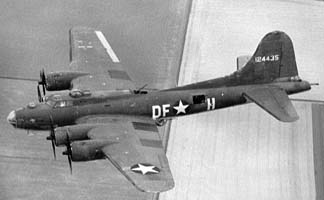|
|

Boeing B-17E Flying Fortress, #41-9091, crashed 15 miles west of Las Cruces, New Mexico on August 23, 1942
Summary: This B-17, assigned to the 427th Bomb Squadron of the 303rd Bomb Group (Hells Angel's), departed Biggs Field, Texas at 1:45am on a night navigational flight that would take the bomber from El Paso to Boise, Idaho and back. Soon after departing Biggs Field, the pilot encountered some lightning and moderate rain as he climbed through heavy cloudbanks to 13,500 feet. Soon after the pilot requested everyone to wear their oxygen masks, the aircraft began to shake and shudder. Engineering Officer Lt. Quentin Hargrove and radioman Sgt. Walter Knox reported that strong centrifugal forces held both men to the floor of the radio compartment. Unable to move, the two men were finally saved from the stricken bomber when the rear section of the fuselage broke apart at the radio room, tossing both men into the thundering night sky. They immediately pulled their ripcords and hit the ground within a few seconds. The bomber crashed nearby. Of the crew of nine, Hargrove and Knox were the only survivors. Investigators speculate the plane may have been struck by lightning, but more likely was the fact that the pilot encountered some trouble near 13,500 feet and he was unable to recover. The strong centrifugal forces may have been the pilot suddenly pulling up when he saw how close to the ground he was after he saw the lights of Las Cruces in the distance. The centrifugal forces caused stress on the airframe that it could not handle and the bomber literally began to break apart in the sky. The crew was: 2nd Lt's James Hudson, pilot; Eugene Rochester, copilot; Frank Johnson, navigator; Leon Shane, navigator; William Simno, bombardier; James Van George, pilot, Quentin Hargrove, engineer officer, Sgt. Cato Myers, flight engineer, Staff Sgt. Walter Knox, radioman. In December of 2006, I was fortunate to have located 88 year-old Quentin Hargrove. He was astonished when I told him I had found his old B-17 crash site. During our long conversation, he vividly recounted bailing out of the Fortress near Las Cruces and landing in the muddy sand while the bomber lay engulfed in flames nearby. Per his request, I mailed him a copy of the USAAF mishap report and photos I had taken of the crash site. A few weeks later, I received a large package in the mail from Quentin. I was quite surprised when I opened it and saw a thank you letter, photos, and his old WWII leather A-2 flight jacket he thought I might appreciate. Quentin died in January of 2007. |